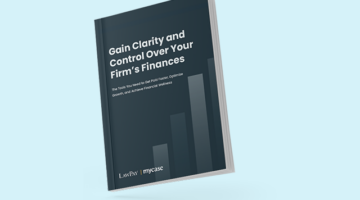 The workplace is like a second household, and your colleagues can be like a second family. But families are often dysfunctional – and we know that harassment and bullying occur in the workplace all too frequently.
The workplace is like a second household, and your colleagues can be like a second family. But families are often dysfunctional – and we know that harassment and bullying occur in the workplace all too frequently.
But some people at work happen to be more vulnerable than others, and the nature of some workplaces makes them more conducive to harassment.
A couple of years ago, two EEOC attorneys noted that in “small towns across America,” many women are afraid to challenge workplace sexual harassment “for fear of invasion of privacy, unfair damage to their reputation in the community, and loss of much-needed employment.”

Private Practice Lawyers: Rater Your Work With In-House Counsel
Please share your thoughts in this brief and anonymous survey.
But these cases are not limited to small-town America – they happen in big cities and in wealthy areas, from tony ski resorts to the Hamptons. Nor are they limited to female employees.
So what makes an employee “vulnerable?” And are you vulnerable?
There seems to be one common theme: powerlessness or a big workplace power differential.
Vulnerability At Work

Take Control Of Your Firm’s Finances With Tools Built For Success
Position your firm for long-term growth with better financial visibility and control. Learn how to track performance, manage spending, and plan strategically—download the full e-book now.
Workers are “vulnerable” for many reasons and in many situations. The powerlessness and/or the low status of their jobs seems to be a common factor. For example, employees may be unable to speak English; they may be physically isolated in the job (e.g., in a field or a warehouse); they may be mentally or physically disabled; or they may fear running afoul of immigration laws.
Or they may be harassed because they are female (or a minority, or gay or lesbian, etc.).
Power differential is key.
Best practice dictates that, at a minimum, employers maintain a corporate policy and practice of zero tolerance of workplace harassment. But what if there are no adequate policies or procedures, or there is a lack of necessary training, or managers simply do not comply or look the other way?
Well, the EEOC alone receives about 100,000 charges of such violations each year, and has made protecting “vulnerable” workers one of its priorities under its Strategic Enforcement Plan (SEP).
Women: The Most Commonly Bullied/Harassed Employees
Let’s briefly acknowledge the recent cases of sexual harassment already well-publicized and covered in the media, except to note that the common thread seems to be a big power differential between the alleged harasser and harassee (and even an untrustworthy “anonymous” harassment hotline).
A little more than a year ago the EEOC announced a $582,000 settlement involving “vulnerable” female workers in a commercial laundry who allegedly were sexually harassed – right here in New York’s summer playground, the swanky Hamptons. And last year the EEOC announced an enormous settlement of $1,020,000 with a Vail condo complex and its management company in another case of sexual harassment.
So bullying/harassment occurs not just in small towns or poor areas.
A recent Canadian news report discussed an academic study which found that female restaurant servers are frequently sexually harassed, because “low wages and a dependence on tips makes some female servers more vulnerable to sexual harassment from customers and colleagues.” “Dependence upon tips” – this nicely illustrates a workplace power differential that fosters harassment.
And finally, an incredible story reported from Scotland. The founder of a charity dedicated to preventing abuse of vulnerable members of Scotland’s ethnic communities was found by a Scottish tribunal – you got it! – to have abused an employee – so badly that “[a] clinical psychologist who later treated the victim said she has been left with major depressive order and post-traumatic stress disorder.”
When “she rejected [his] advances,” he began a campaign of “calculated and premeditated” harassment of her, “carried out a campaign of verbal and physical abuse against her, including making ‘sexually explicit remarks;’ … and ‘made threats of violence to her family.’”
The founder of an anti-abuse charity!
I guess that lofty and noble corporate goals do not always translate into civil, non-sexist acts and behavior.
Women In Agriculture
It seems that female farm workers are among those most at risk.
The EEOC settled a case in which two Colorado potato-packing companies allegedly permitted the sexual harassment of female workers by a supervisor who subjected many of them to “sexual comments and gestures, propositioning [them], touching them on their buttocks and breasts, and in at least one instance, pulling a female employee onto his lap.”
EEOC officials said that “This case is the latest in a long-series of cases challenging sexual harassment in the agricultural industry, often directed at immigrants from Mexico and Latin America. … EEOC considers protecting immigrant, migrant and other vulnerable workers from discrimination and harassment a priority” under its Strategic Enforcement Plan (“SEP”).
Enormous damages of $1.47 million were awarded to a class of sexually harassed female California farmworkers when the court found that two supervisors subjected them to “conditioning promotions and employment on sexual favors, continuous sexual advances, stalking female employees and unwanted physical touching and leering.”
And another settlement announced last February resolved sexual harassment claims against “[o]ne of the largest apple producers in the United States.”
Harassment Of The Disabled
Let’s look at workplaces where perhaps the most egregious harassment tends to occur – I think of the infamous case of Henry’s Turkey as best exemplifying employee abuse in isolated areas, especially where workers are disabled. This poultry company exploited mentally disabled workers by, among many other things, paying them $65 a month to eviscerate turkeys, and keeping them as virtual slaves. Dan Barry at the NYT wrote a number of moving pieces about these workers, which became national news.
And I found dozens of cases just like Henry’s.
Finally, the City of Los Angeles had to pay over $4 million to a city gardener who, because of serious brain trauma injuries, “suffered from slower speech, cognitive development issues, difficulty in thinking, and the tendency to repeat himself.” His supervisor used his mental disability “as an opportunity for mistreatment and trickery, even hiding [his] tools from him so that he was unable to clean his assigned park.” Nice.
All employers, no matter the size or place, are given a black eye by acts of bullying, harassment, and cruel exploitation such as I described. Employers and trade groups nationwide should take the lead in eliminating such exploitation, not only for the obvious sake of the workers, but also to protect their good name.
If they don’t, the EEOC may just do it for them.
 Richard B. Cohen has litigated and arbitrated complex business and employment disputes for almost 40 years, and is a partner in the NYC office of the national “cloud” law firm FisherBroyles. He is the creator and author of his firm’s Employment Discrimination blog, and received an award from the American Bar Association for his blog posts. You can reach him at [email protected] and follow him on Twitter at @richard09535496.
Richard B. Cohen has litigated and arbitrated complex business and employment disputes for almost 40 years, and is a partner in the NYC office of the national “cloud” law firm FisherBroyles. He is the creator and author of his firm’s Employment Discrimination blog, and received an award from the American Bar Association for his blog posts. You can reach him at [email protected] and follow him on Twitter at @richard09535496.